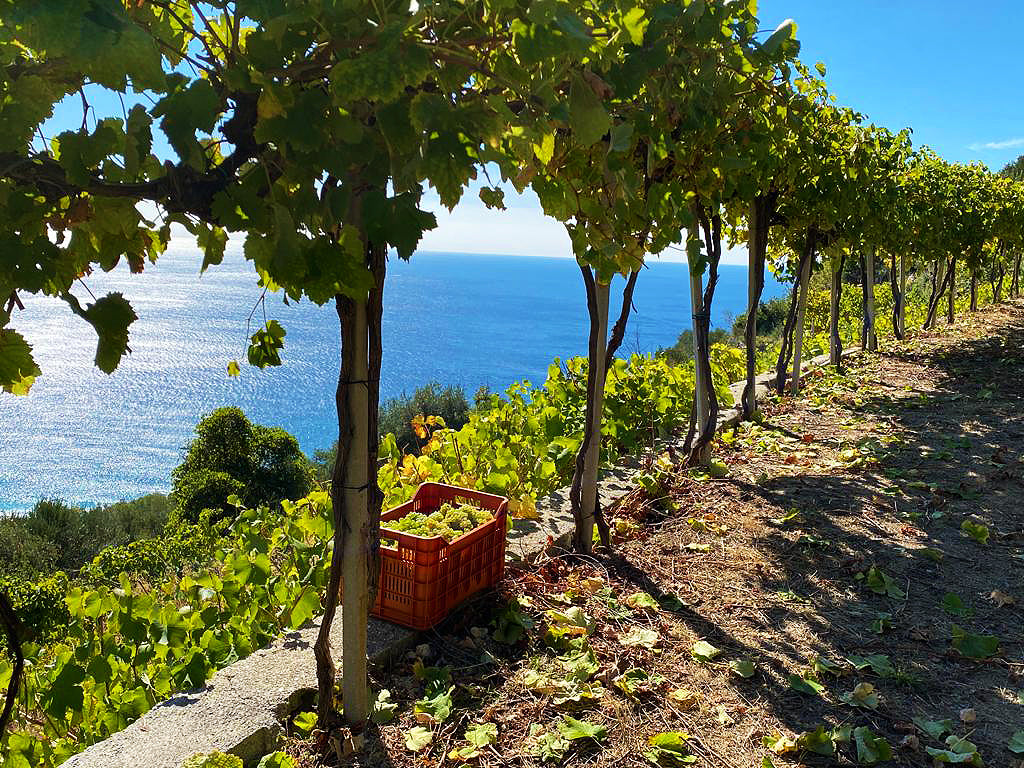LIGURIA
Though arguably most associated with France, the Riviera - as concept, aspiration, and actuality - originates in Liguria, in northwestern Italy. The word itself is Italian for “coastline,” and was first applied to the 350 miles of waterfront that traces the narrow corridor between the Maritime Alps, the Apennine mountains and the Ligurian Sea. When 19th century English vacationers strolled over the northern border with France, they extended their remit to encompass the Cotes D’Azur and present-day Monaco (where a variation of the Ligurian dialect, called Monégasque, is still a compulsory subject in local schools). The etymology of ‘Liguria’ itself is much older and more obscure, though the word is likely derived from the ancient Ligures people, who are thought to have once occupied a remarkably large swath of Mediterranean Europe, including parts of Southern France, present-day Catalonia on the Iberian Peninsula, and Piedmont down to Sicily, in Italy. Not sure why this once vast aggregation ended up appellate to Italy’s third-smallest region, but it's appropriate because Liguria has always supported multitudes.
Indeed, while I’ve thus far struggled mightily to avoid this particular tourist trap in IWC, I might as well take the L here and concede defeat: Liguria is an actual land of contrasts. One of the most densely populated parts of Italy, the territory is 65% mountains, and 80% of the inhabitants choose to live elsewhere - in the conurbations that limn the coast: Sanremo, Savonia, La Spezia and Genoa, Italy’s busiest seaport and the regional capital. You can pivot your visit around cityscapes and beaches, and/or hike up to and around alpine villages carved out of rock, including the world-famous but still surprisingly inaccessible ring of fishing villages known collectively as Cinque Terre. You will hear a dialect bearing traces of Portuguese, Sardinian, Celtic and Arabic that is barely intelligible to other Italians; you will not see (or taste) many tomatoes - an afterthought in the birthplace of pesto. You will drink beach wine whose breezy maritime resonances belie the backbreaking work required to make them.
Like most places in Italy, Liguria’s enological story began in antiquity. It’s not certain whether the Greeks or the Phoenicians introduced the vine to Liguria, but by the time the Romans passed through the region, wine from Liguria was prized both for its quality and its scarcity. This remains true today, as only the much smaller and less populated Vallee D’Aosta produces less vino by volume per annum. Both places require what the Italians call viticulture eroica (heroic viticulture), as vineyards occupy impossibly steep slopes hostile to machinery of any kind, necessitating painstaking by-hand cultivation to pry these tiny yields from the recalcitrant dirt.
Our two selections this month pretty much epitomize this ethos. The white comes from Punta Crena, one of my favorite wineries in the world. The Ruffino family behind it have been farming the same vineyards above the tiny beach village of Varigotti for 500 years; the current generation even builds their stone terraces by hand. The grape is Pigato, often confused with Vermentino, though the Ruffinos are dedicated to illustrating the difference.
The Ka' Manciné winery responsible for the red is new to me but equally impressive. Maurizio Anfosso and Roberta Repaci, the couple behind the label, are focused on the Rossese di Dolceacqua grape, an exceedingly rare light red varietal grown only in the Riviera (including in France, where it is known as Tibouren). They farm some of the tallest vineyards in the region, in a village called Soldano, which has its own dialect. This Rossesse comes from vines planted in 1872, and it is a savory and mineral-driven revelation.
Salut!
Alan Hicks
|
Punta Crena Pigato Riviera Ligure di Ponente Vigneto Ca’ da Rena 2023 |
|
|
Region: Liguria, Italy |
About the Winery: The tiny village of Varigotti comprises just a few rows of houses and restaurants along a pristine Mediterranean beach. Climb up into the hills, and you will discover neatly terraced vineyards on the slopes and in hidden clearings further up on the peaks. The Ruffino family has been living here and tending to these vineyards for more than 500 years. Today four siblings run the estate: Tommaso, the eldest, is the winemaker; Paolo is the salesman; Anna handles logistics; and Nicola helps out in the vineyards and winery. Their cellars are in Varigotti, pop. 500 (though that doubles during the summer months). The vineyards of Punta Crena (which is named for a large promontory jutting into the sea at the edge of the village) are all within 1,200 meters of the water and enjoy sea breezes that help keep the grapes healthy and happy. Ask Paolo if the family follows organic methods in the vineyards and he’ll laugh. We’re not “organic,” he says as if you had asked about some crazy new technology. We just do everything the same way our ancestors have for hundreds of years. They even build their stone terraces by hand, using the method established here three thousand years ago. About the Winemaking: The terraced vineyards are at 100-300 m altitude and within 1.2 km of the sea. Everything is vinified in stainless steel. No machines are used for pumping over; the pressure resulting from the release of gas during fermentation is used instead, and the wines are neither filtered nor fined. The rocks in Varigotti have an unusually high aluminum content; as the rock breaks down, the aluminum is released and washes into the clay soil, where over several years it oxidizes and turns red. This soil is found only in Varigotti and certain areas of Provence (which is just a few hours away by car). Pigato is a genetic variation of Vermentino that developed around the 18th century and was probably named for its pighe—“freckles” in the local dialect, referring to its spotty skin. Today, the two varieties are often confused because they are frequently planted together and cross-pollinate in the vineyards, but the difference is evident when they are kept separate, as at Punta Crena. In order to demonstrate this distinction scientifically, the Ruffinos are planning to provide cuttings of their own vines to a local university for comparative genetic testing. Tasting Notes: Light-medium-bodied with piquant acidity and herbal qualities that counter the mid-weight concentration of orchard fruits, all of which is left lingering on the finish with a subtle saline minerality and almond. |
|
Winemaker: Tommaso Ruffino |
|
|
Price per bottle / per case: $31.99/$345.50 |
|
|
Suggested Food Pairing: Perfect on its own, but also makes a great match for pesto pasta, light seafood preparations, and mild cheeses. Pesto pasta w/ potatoes and green beans (see recipe) |
|
|
Ka' Manciné Rossese Di Dolceacqua ‘Bergana’ 2023 |
|
|
Region: Rossese di Dolceaqua DOC |
About the Winery: Ka' Manciné is a tiny estate in western Liguria, almost on the border with France, in the Rossese di Dolceacqua DOC. Maurizio Anfosso and Roberta Repaci own about 3 hectares of the Rossese variety, in the Beragna and Galeae crus. Maurizio and Roberta's wines are pale in color, medium-bodied, extremely fresh and spicy, with a lovely silky texture and refreshing juiciness. Lighter red wines are some of the best food wines, and these are some of Italy's most attractive examples. Rossese del Dolceacqua is a local grape grown in a very limited area (about 200 acres, for a total production of 200,000 liters) on steep terraces made of schists and marls facing mostly East and South-East at altitudes between 300 and 450 meters above sea level. The very old and low-yielding vines are planted at high density (up to 8000 vines per hectare) in the classic Greek bush system. Maurizio Anfosso and Roberta Repaci, owners of Ka Mancinè, work the beautiful vineyards of Beragna and Galeae manually, with sheer respect for the environment and in harmony with the land. About the Winemaking: 100% Rossese. The Beragna vineyard was planted on its own roots in 1872 on very steep terraces facing southeast on schists and marls, at an altitude of about 400 meters. Harvested the second half of September with ten days' maceration and controlled low-temperature fermentation in stainless steel with indigenous yeasts 7 months aging in stainless steel. No fining, light filtration prior to bottling. 12,000 bottles produced annually. Tasting Notes: Beragna is brimming with cherry and strawberry fruit and hints of dried herbs, spice and pepper. The palate is juicy and refreshing with crisp acidity and mineral notes. |
|
Winemaker: Maurizio Anfosso and Roberta Repaci |
|
|
Price per bottle / per case: $21/$226.80 |
|
|
Suggested Food Pairing: Pesto pasta w/ potatoes and green beans (see recipe) spaghetti allo scoglio, braised rabbit with taggiasca olives and pine nuts. Pesto pasta with shrimp and prosciutto Clams w/ oregano and bread crumbs. |
|
Pesto Pasta Liguria with Potatoes and Green Beans
Doesn’t get more quintessentially Ligurian than this. Basil pesto or pesto Genovese is ubiquitous in Ligurian cuisine, the regional calling card. This pesto pasta Liguria with potatoes and green beans recipe is one of the most traditional ways they eat pesto here, and it is always homemade.
Ingredients
-
320 g corzetti pasta or Trofie or trenette (or trofie or linguine or fettuccine or penne.)
-
120 g fresh green beans
-
120 g potatoes You can use red potatoes. I like new potatoes.
For the pesto
-
4 handfuls of fresh basil leaves, preferably young. (In Liguria they use Basilico Genovese D.O.P.)
-
30 g pine nuts (I like to toast mine.)
-
50 g Parmesan (In Liguria they use aged Parmesan)
-
30 g Pecorino from Sardinia
-
1-2 garlic cloves peeled. (In Liguria they use garlic from Vessalico)
-
coarse sea salt for pasta and to taste
-
extra virgin olive oil as required
Instructions
Make the pesto
-
If it’s possible, choose medium sized young basil leaves (brighter green). Rinse the leaves under water and dry them with paper towels. Dry fry the pine nuts for 2-3 minutes if you prefer to have them toasted.
Using a pestle and mortar
-
Peel the garlic cloves and put them into a mortar with pine nuts.
-
Grind until you have a paste. Then add some basil leaves, a little coarse salt, and 3 tablespoons of olive oil.
-
Keep working with the pestle, while continuing to add more basil leaves and olive oil until the pesto is smooth and consistent. Finally, transfer to a bowl and add the cheeses and stir well.
Using a blender or mini food processor
-
You can either put all the ingredients in the blender and pulse a few seconds at a time until you have the right consistency. Don’t keep pulsing for too long at once as the blender will heat up and this can spoil the basil.
-
Alternatively, crush the pine nuts in a pestle and mortar or with a hammer. Blend the olive, oil, basil, salt and garlic until you have the right consistency. Add the cheese and crushed pine nuts after. Mix well with a fork or wooden spoon.
Cooking the other ingredients
-
Wash the vegetables, then top and tail the green beans and cut them into 2 or 3 pieces. Peel the potatoes and cut into cubes.
-
Fill a large pot with water and bring to boil, then add the sea salt.
-
Either boil the vegetables along with pasta until all are “al dente”, or cook separately.
-
You can cook the beans and potatoes together and then remove them to a bowl with a slotted spoon. (I did this)
-
Finally, cook the pasta al dente in the vegetable water according to the instructions on the packet. Save a cup of the cooking water and drain the pasta.
-
Mix the pesto with the potatoes and green beans in a frying pan over a low heat for a minute or in a bowl. Then add the drained pasta and a little pasta cooking water. Mix everything together carefully and serve with extra grated cheese and some more toasted pine nuts if required.





